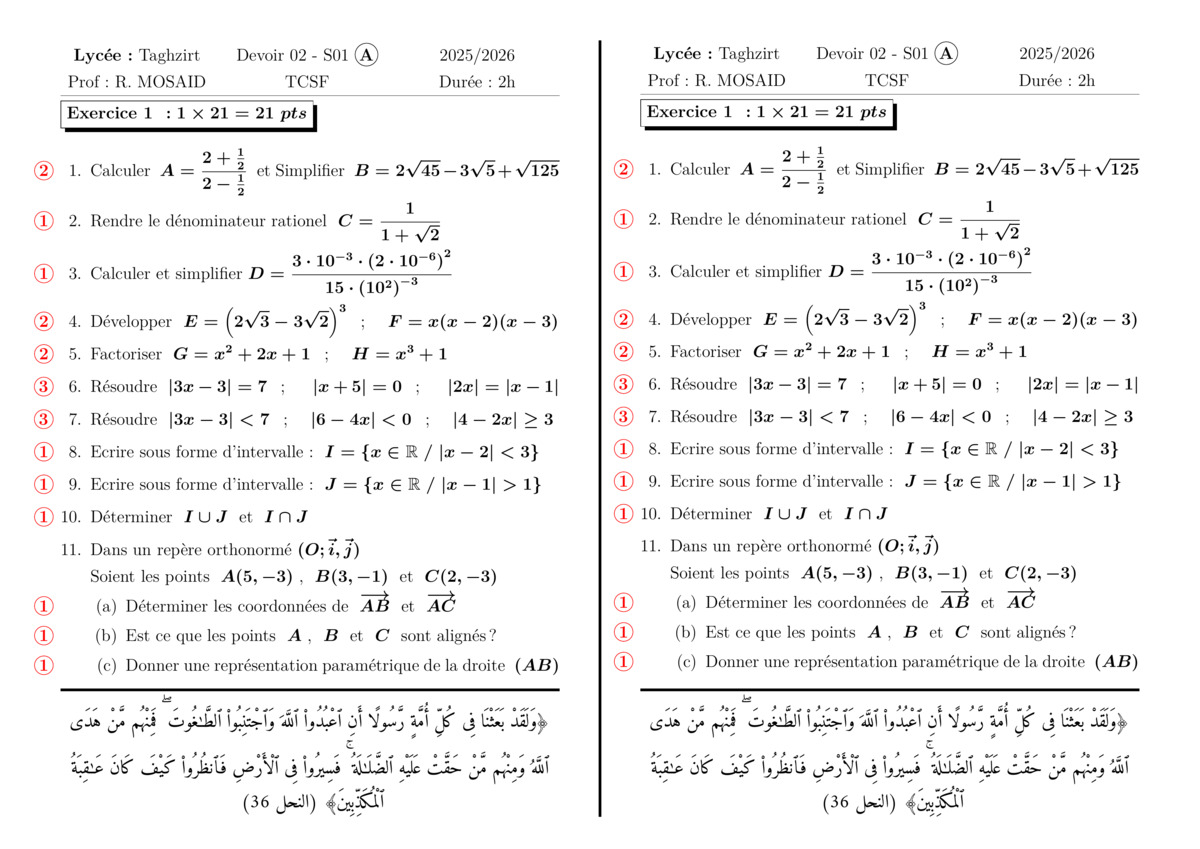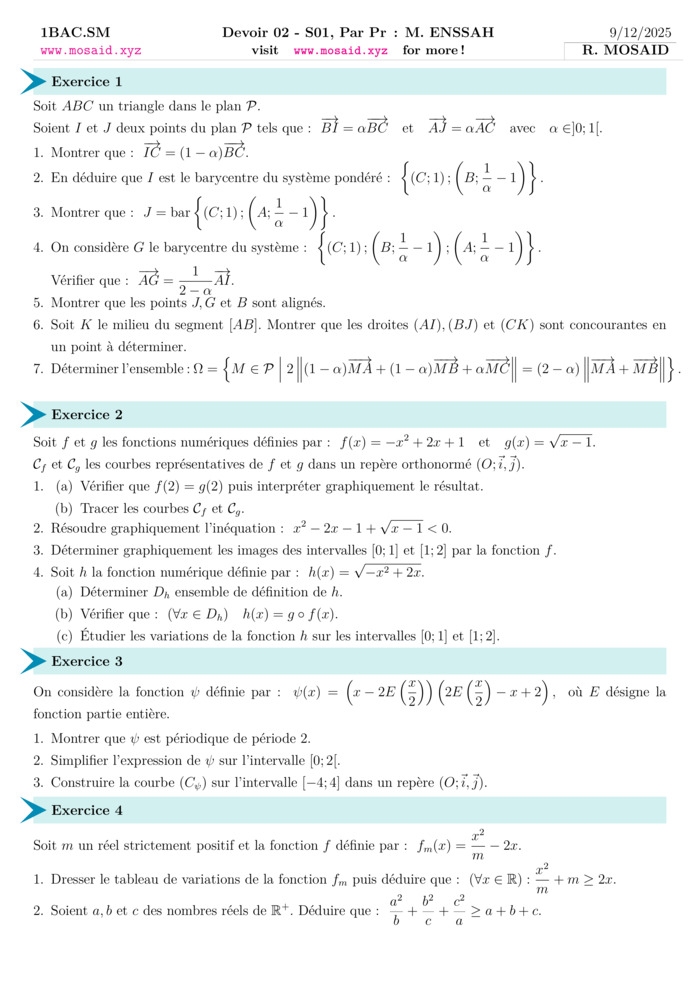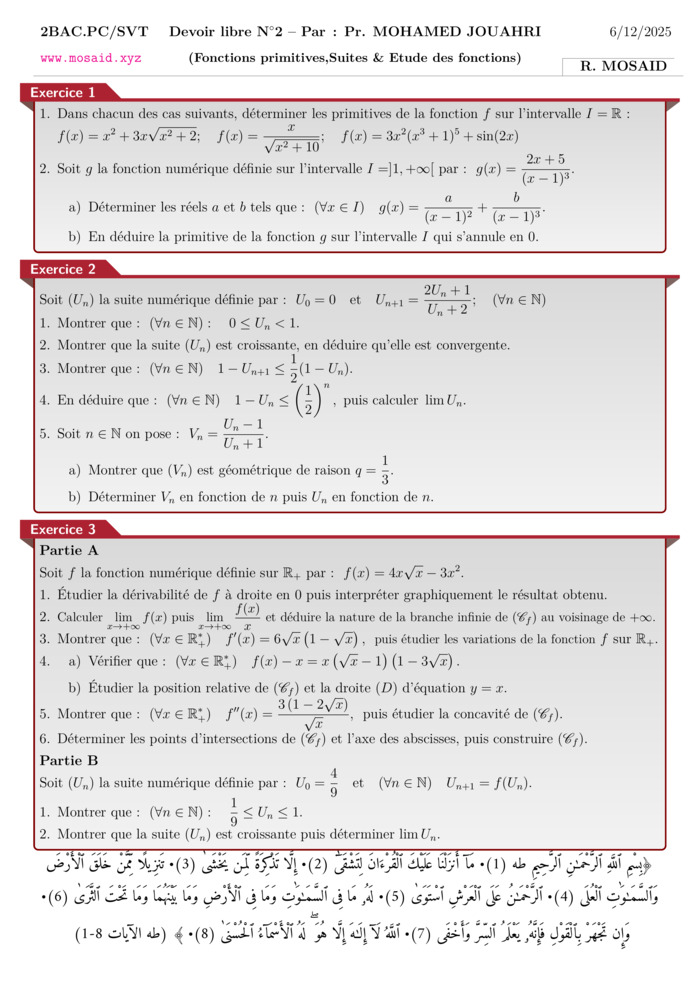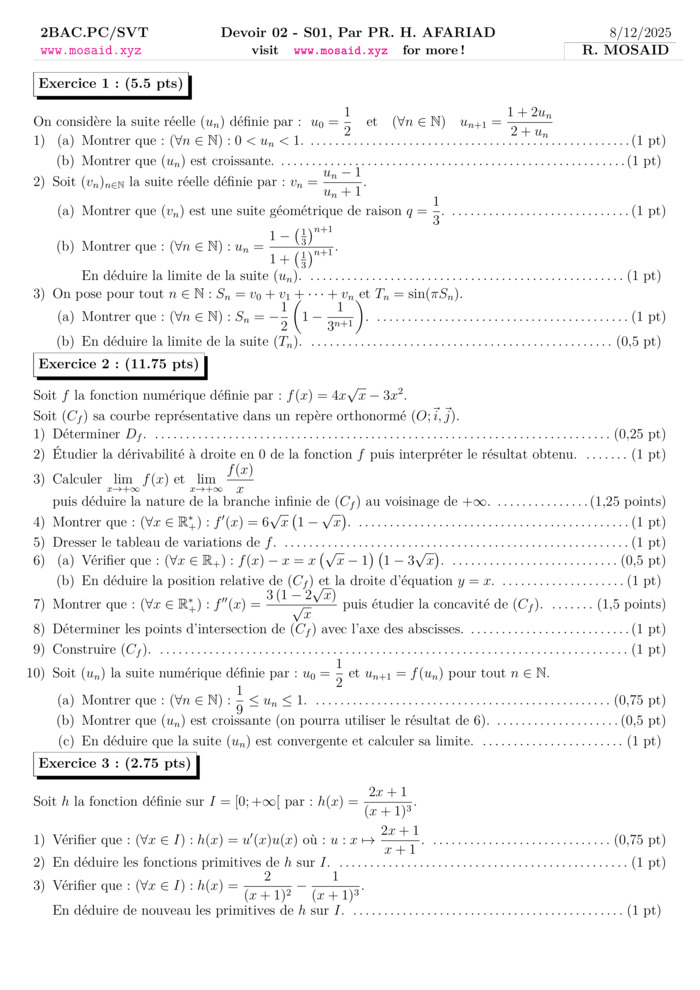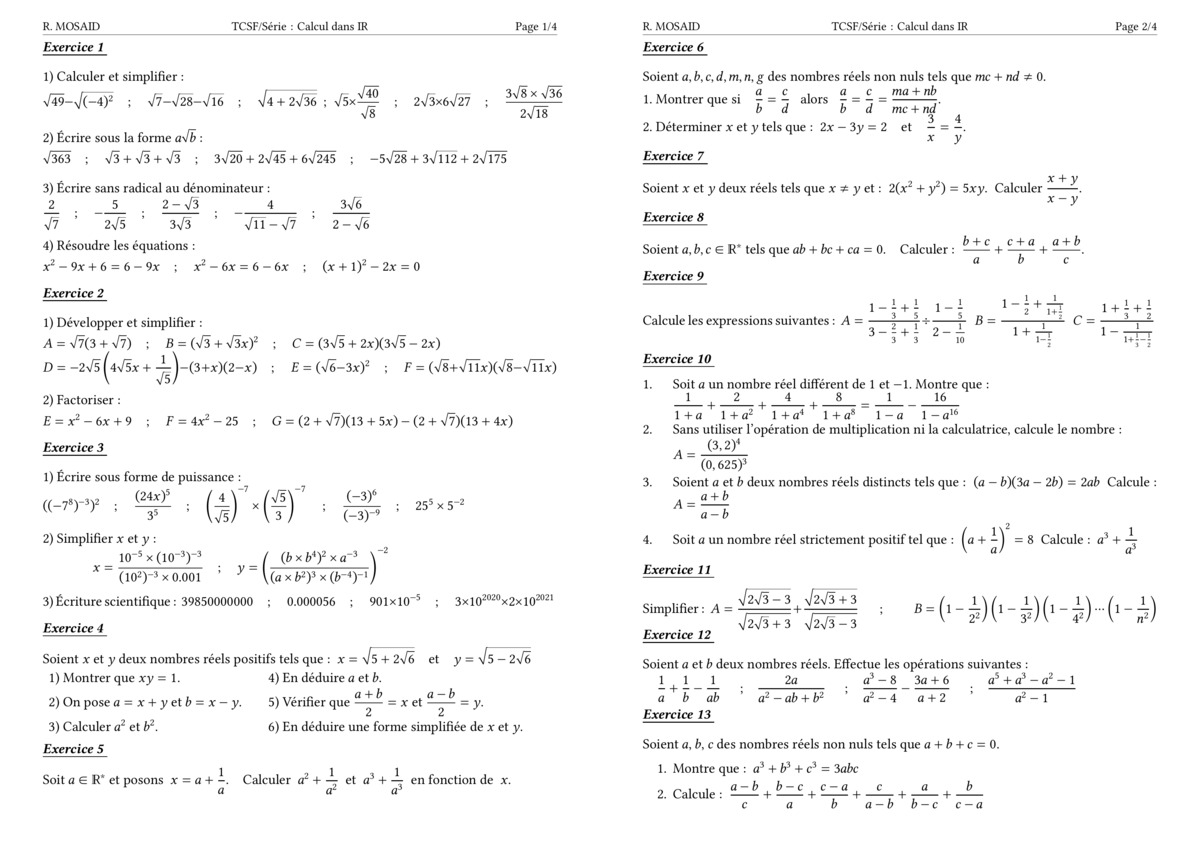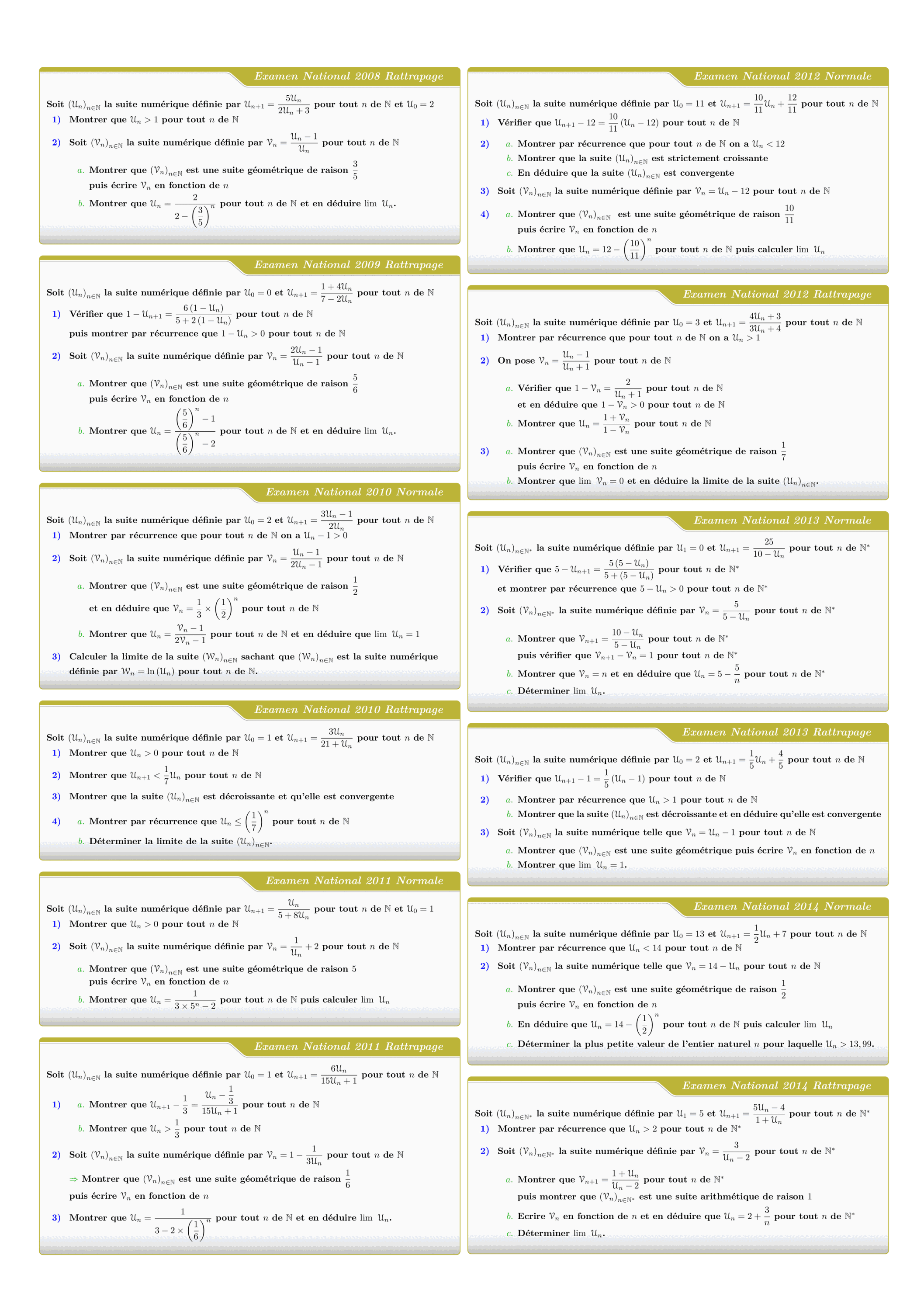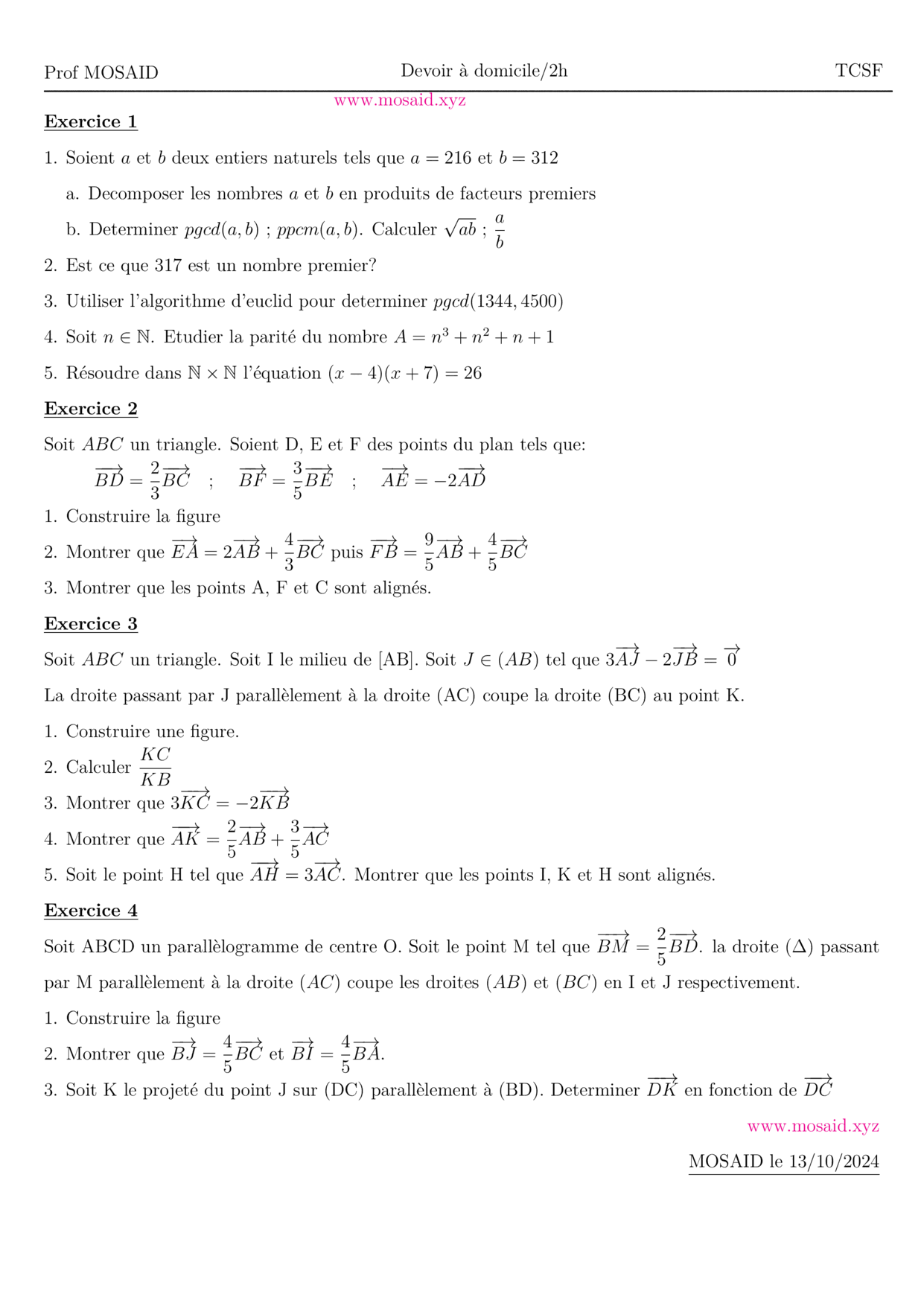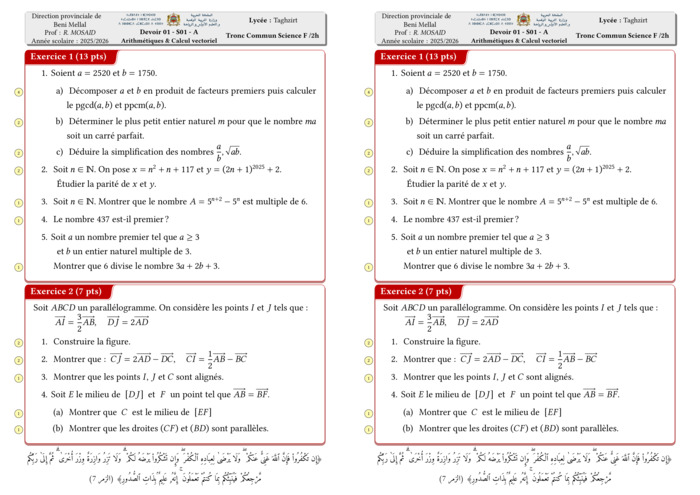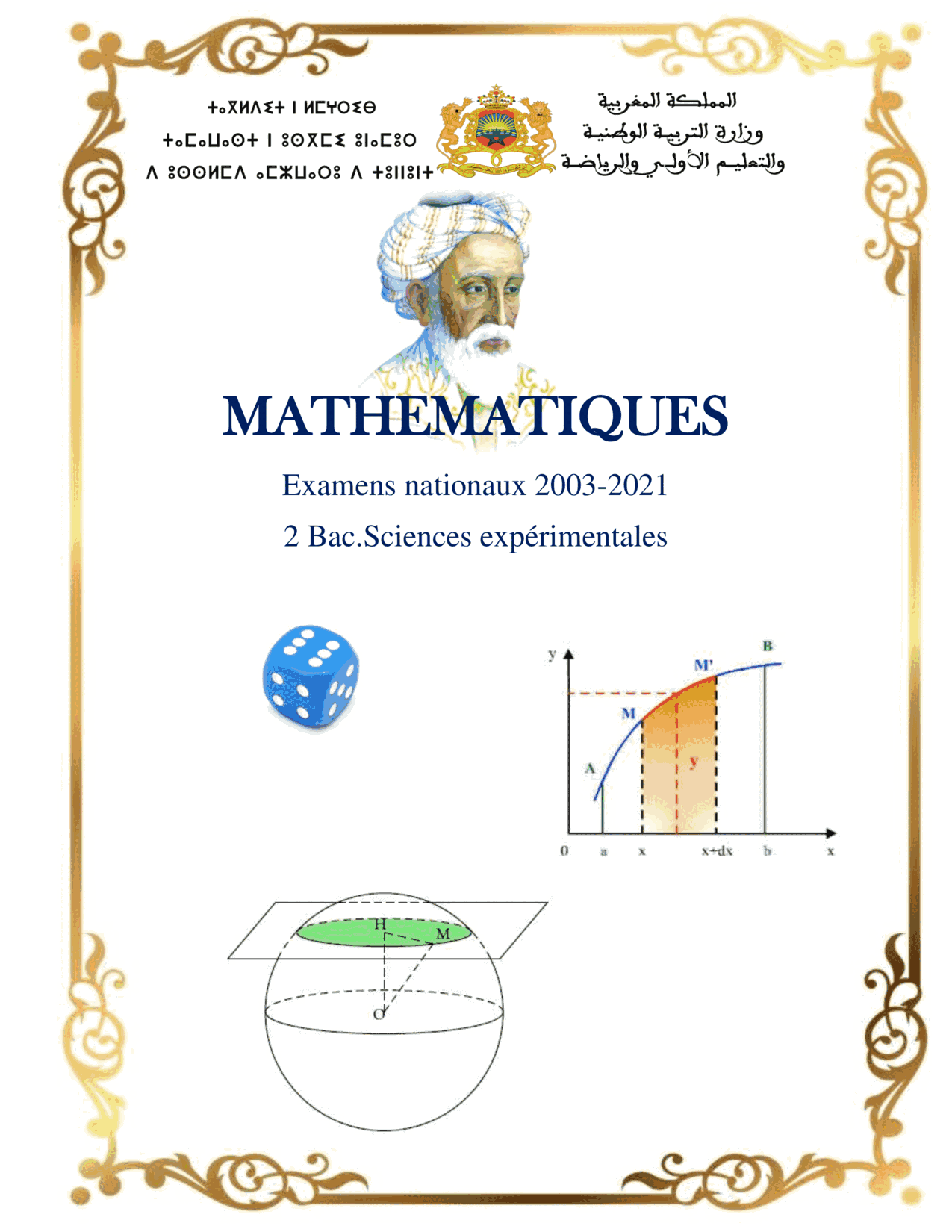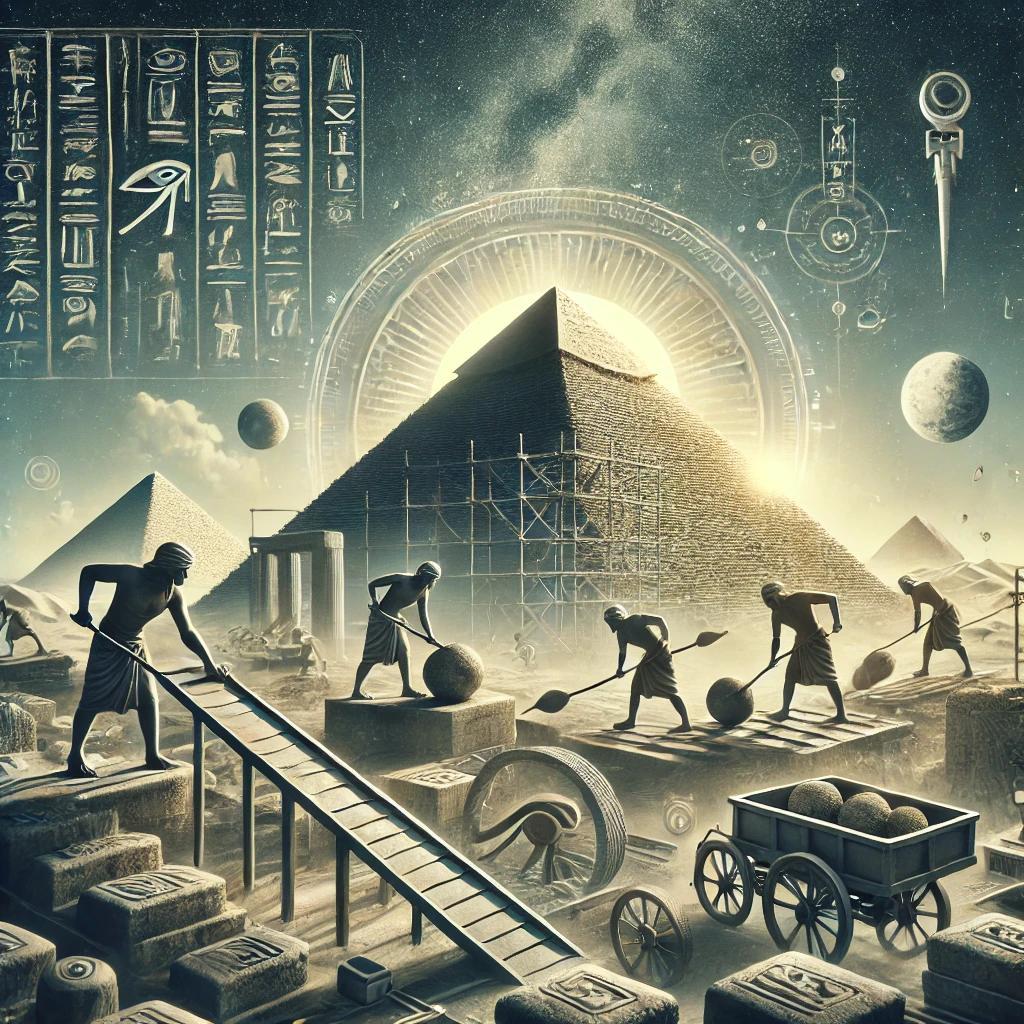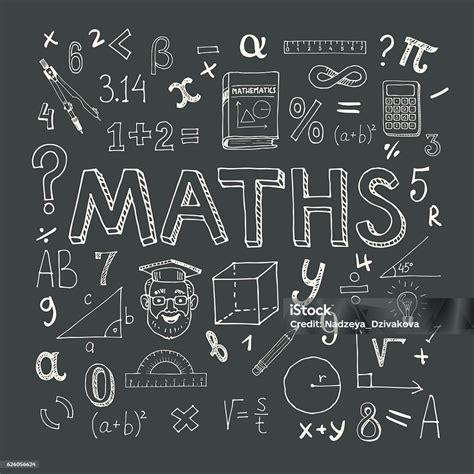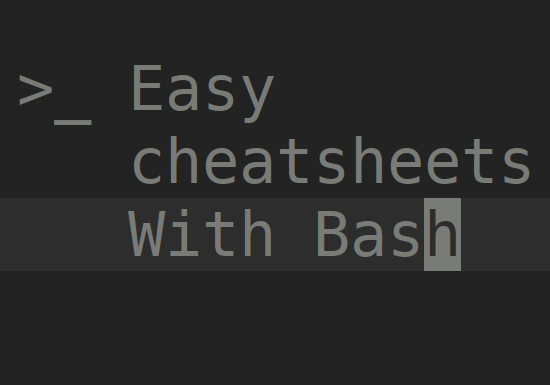Correction : Control 1 (A) , Artithmetiques, Calcul vectoriel et projection
📅 October 29, 2024 | 👁️ Views: 753

\documentclass[12pt,a4paper]{article}
\usepackage{tabularx}
\usepackage{booktabs}
\usepackage{ragged2e}
\usepackage[left=1.00cm, right=1.00cm, top=0.50cm, bottom=2cm]{geometry}
\usepackage{amsmath,amsfonts,amssymb}
\usepackage{fontspec}
\usepackage{mathrsfs}
\usepackage{setspace}
\usepackage{multirow,multicol}
\usepackage{xcolor}
\usepackage[ddmmyyyy]{datetime}
\usepackage{tikz,tkz-tab}
\usetikzlibrary{shapes,decorations.text,calc}
\usepackage{hyperref}
\setstretch{1.7}
\setlength{\columnsep}{0.4cm} % Adjust space between columns
\setlength{\columnseprule}{0.4pt} % Width of the vertical line
\hypersetup{
colorlinks=true,
linkcolor=blue
}
\newcommand{\mylink}{\href{https://mosaid.xyz/cc}{www.mosaid.xyz}}
\newcommand{\stamp}[2]{
\begin{tikzpicture}[remember picture, overlay]
\coordinate (A) at (#1,#2);
\draw[red!50] (A) circle (1.9cm);
% Draw the inner circle
\draw[red!50] (A) circle (1.4cm);
% Draw the curved line
\draw[red!50, decorate, decoration={text along path,
text={|\fontspec{DejaVu Sans}\color{red!75}\bfseries|★MOSAID RADOUAN★},
text align={align=center}, raise=-3pt}] (A) ++ (180:1.6cm) arc (180:0:1.6cm);
\draw[decorate, decoration={text along path,
text={|\fontspec{DejaVu Sans}\color{red!75}\bfseries|∞★~mosaid.xyz~★∞ },
text align={align=center}, raise=-6.5pt}] (A) ++ (180:1.53cm) arc (-180:0:1.53cm);
\node[red!75,font=\fontsize{48}{48}\fontspec{DejaVu Sans}\bfseries\selectfont] at (A) {✷};
\end{tikzpicture}
}
\everymath{\displaystyle}
\begin{document}
\noindent
\begin{center}
\begin{tabular}{@{}p{0.22\textwidth}p{0.57\textwidth}p{0.17\textwidth}}
%\toprule
\multirow{2}{*}{\parbox{\linewidth}{Prof MOSAID \newline \mylink }}
& \Centering {Correction Control N 01 - A} & \hfill TCS \\
\bottomrule
\end{tabular}
\end{center}
\noindent
\textbf{\underline{Exercice 1:}}\\
\noindent
Soient $x=2420$ et $y=6930$\\
1.a la décomposition:\\
\vspace*{-2cm}
\begin{center}
\begin{tabular}{r|l}
2420&2\\
1210&2\\
605&5\\
121&11\\
11&11\\
1&\\
\end{tabular}
\hspace*{1cm}
\begin{tabular}{r|l}
6930&2\\
3465&5\\
693&3\\
231&3\\
77&7\\
11&11\\
1&\\
\end{tabular}
\end{center}
Donc $x=2^2 \times 5 \times 11^2$ ~~~~et~~~~ $y=2 \times 3^2 \times 5 \times 7 \times 11$\\
On a $pgcd(x,y)=2 \times 5 \times 11 = 110$ ~~~et~~~ $ppcm(x,y)=2^2 \times 3^2 \times 5 \times 7 \times 11^2$\\
On a $\sqrt{\textcolor{red}{5}x}=\sqrt{\textcolor{red}{5}\times 2^2 \times 5\times 11^2}=
\sqrt{5^2\times 2^2 \times 11^2}=2 \times 5 \times 11 = 110$\\
$\sqrt{\frac{\textcolor{red}{35}y}{\textcolor{red}{22}}}=
\sqrt{\frac{\textcolor{red}{5 \times 7} \times 2 \times 3^2 \times 5 \times 7 \times 11 }{\textcolor{red}{2 \times 11}}}=
\sqrt{3^2 \times 5^2 \times 7^2 \times 11^2} = 3 \times 5 \times 7 \times 11$\\
Utiliser l'algorithme d'euclid pour determiner $pgcd(x,y)$\\
On a
\setlength{\abovedisplayskip}{0pt}
\setlength{\belowdisplayskip}{0pt}
\begin{align*}
6930&=2420 \times 2 + \textbf{2090}\\
2420&=2090 \times 1 + \textbf{330}\\
2090&=330 \times 6 + \textbf{\textcolor{red}{110}}\\
330&=110 \times 3 + \textbf{0}
\end{align*}
\setlength{\abovedisplayskip}{\baselineskip}
\setlength{\belowdisplayskip}{\baselineskip}
Le dernier rest non nul est le pgcd donc $pgcd(x,y)=110$\\
2. On a $\sqrt371=19.2$. les nombres premiers inférieurs ou égals à $\sqrt371$ sont 2,3,5,7,11,13,17 et 19\\
On a 371 n'est pas divisible par 2 car impaire\\
on a $3+7+1=11$ donc il n'est pas divisible par 3\\
aussi il n'est pas divisible par 5\\
On effectue la division euclidienne par 7 on trouve $371=7 \times 53$\\
Donc 371 n'est pas premier.\\
\stamp{14}{2}
\clearpage
3. Soint $ n \in\mathbb{N}$. On a $a=n^2-n+1$\\
\begin{multicols}{2}
si $n$ est paire \\
donc il existe $k \in\mathbb{N}$ tel que $n=2k$\\
donc
\setlength{\abovedisplayskip}{0pt}
\setlength{\belowdisplayskip}{0pt}
\begin{align*}
a&=n^2-n+1\\
&=(2k)^2-2k+1\\
&=2(2k^2-k)+1
\end{align*}
\setlength{\abovedisplayskip}{\baselineskip}
\setlength{\belowdisplayskip}{\baselineskip}
donc impaire
\columnbreak
si $n$ est impaire\\
donc il existe $k \in\mathbb{N}$ tel que $n=2k+1$\\
donc
\setlength{\abovedisplayskip}{0pt}
\setlength{\belowdisplayskip}{0pt}
\begin{align*}
a&=n^2-n+1\\
&=(2k+1)^2-(2k+1)+1\\
&=4k^2+4k+1-2k+1-1\\
&=4k^2+2k+1\\
&=2(k^2+k)+1
\end{align*}
donc impaire
\end{multicols}
4. On a $D_{42}=\{1,42,2,21,3,14,4,6,7\}$\\
\noindent
\textbf{\underline{Exercice 2:}}\\
1. La figure:\\
$\overrightarrow{AI}=\frac{1}{2}\overrightarrow{AB}$\\
$\overrightarrow{AJ}=\frac{2}{5}\overrightarrow{AC}$\\
$\overrightarrow{BK}=-2\overrightarrow{BC}$\\
\hspace*{7cm}
\begin{tikzpicture}[remember picture, overlay]
\coordinate (A) at (5,5);
\coordinate (B) at (3,2);
\coordinate (C) at (6,2);
\coordinate (I) at ($(A)!0.5!(B)$);
\coordinate (J) at ($(A)!0.4!(C)$);
\coordinate (K) at ($(C)!3!(B)$);
\draw (A) -- (B) -- (C) -- cycle;
\draw[->,thick,blue] (A) -- (I);
\draw[->,thick,red] (A) -- (J);
\draw[->,thick,red!75] (B) -- (K);
\node[above right] at (A) {A};
\node[below left] at (B) {B};
\node[below right] at (C) {C};
\node[above left] at (I) {I};
\node[above right] at (J) {J};
\node[above right] at (K) {K};
\node[thick, font=\tiny, rotate=30] at (I) {|};
\node[thick, font=\tiny, rotate=-30] at (J) {|};
\node[thick, font=\tiny, rotate=30] at ($(B)!0.5!(K)$) {|};
\end{tikzpicture}
\stamp{8}{4}
\begin{multicols}{2}
\setlength{\abovedisplayskip}{0pt}
\setlength{\belowdisplayskip}{0pt}
On a:
\begin{align*}
\overrightarrow{AJ}&=\frac{2}{5}\overrightarrow{AC}\\
\overrightarrow{A\textcolor{red}{I}}+\overrightarrow{\textcolor{red}{I}J}&=\frac{2}{5}\overrightarrow{AC}\\
\overrightarrow{IJ}&=-\overrightarrow{AI}+\frac{2}{5}\overrightarrow{AC}\\
\overrightarrow{IJ}&=-\frac{1}{2}\overrightarrow{AB}+\frac{2}{5}\overrightarrow{AC}
\end{align*}
\hrule
\noindent
On a $\overrightarrow{IK}=\frac{5}{2}\overrightarrow{AB}-2\overrightarrow{AC}$\\
Donc $\overrightarrow{IK}=-5\left(-\frac{1}{2}\overrightarrow{AB}+\frac{2}{5}\overrightarrow{AC}\right)$\\[0.5cm]
Alors $\overrightarrow{IK}=-5\overrightarrow{IJ}$ \\
Donc les vecteurs sont colinèaires\\
Donc les points I,J et K sont alignés.
\columnbreak
\begin{align*}
\overrightarrow{BK}&=-2\overrightarrow{BC}\\
\overrightarrow{B\textcolor{red}{A}}+\overrightarrow{\textcolor{red}{A}I}
+\overrightarrow{\textcolor{red}{I}K}&=-2\overrightarrow{B\textcolor{red}{A}}-2\overrightarrow{\textcolor{red}{A}C}\\
\overrightarrow{\textcolor{red}{A}I}+\overrightarrow{\textcolor{red}{I}K}&=-3\overrightarrow{BA}-2\overrightarrow{AC}\\
\frac{1}{2}\overrightarrow{AB}+\overrightarrow{IK}&=-3\overrightarrow{BA}-2\overrightarrow{AC}\\
\overrightarrow{IK}&=-\frac{1}{2}\overrightarrow{AB}-3\overrightarrow{BA}-2\overrightarrow{AC}\\
\overrightarrow{IK}&=-\frac{1}{2}\overrightarrow{AB}+3\overrightarrow{AB}-2\overrightarrow{AC}\\
\overrightarrow{IK}&=-\frac{1}{2}\overrightarrow{AB}+\frac{6}{2}\overrightarrow{AB}-2\overrightarrow{AC}\\
\overrightarrow{IK}&=\frac{5}{2}\overrightarrow{AB}-2\overrightarrow{AC}\\
\end{align*}
\textcolor{white}{.}\hfill \underline{MOSAID le \today}\\
\vspace*{-1cm}
\textcolor{white}{.}\hfill \mylink
\end{multicols}
\end{document}
Related Courses, Exams, and Exercises
Solution PDF:
📥 Download Correction : Control 1 (A) , Artithmetiques, Calcul vectoriel et projection (PDF)
if you find this content helpful, Please consider supporting me with a small donation
إن وجدت هذا المحتوى مفيدا، من فضلك إدعمني بمبلغ بسيط كتبرع
Buy me a coffee — إشتر لي قهوة
PayPal.me • عبر بايبالOr bank transfer • أو حوالة بنكية
Titulaire : RADOUAN MOSAID RIB : 230 090 6501953211022000 65 IBAN : MA64 2300 9065 0195 3211 0220 0065 BIC / SWIFT : CIHMMAMC
